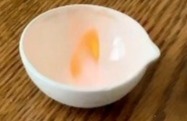In this experiment we will see flames glowing with different colors when the fire material has a metallic salt added to it.
Difficulty: Hard, require adult supervision
Materials:
1. Copper Sulphate : 1 tea spoon
2. Sodium Chloride (Common salt) : 1 tea spoon
3. Ethyl Alcohol : few drops for each salt (around 20 ml)
4. Heat resistant crucible to conduct the experiment
5. A lighter or match stick
Procedure
Add salt to the crucible
Add a few drops of Ethyl Alcohol, just enough to soak the salt. I used 70% rubbing alcohol
Use the lighter to light the alcohol
The flame after a few seconds will be colored based on the salt in the crucible.
Here is a video of the experiment
How It Works:
To understand how flame test works, we first need to understand the structure of atoms of elements. All elements are comprised of atoms, which in turn have a nucleus of protons and neutrons surrounded by electrons that are orbiting around the nucleus, like the picture below

The protons in the nucleus have positive charge, while the electrons that are orbiting have negative charge. In an atom, the number of protons and electrons are the same, so the net charge of an atom is zero. Neutrons have no charge. As you can see from the picture, the electrons are orbiting in different levels around the nucleus (imagine the various planets orbiting the sun) and are kept bound to their orbitals by the attraction to the nucleus. The electrons orbiting at the highest levels are farther from the nucleus, so the force holding them are lower than those at the lower levels. Every element has its own number of protons and electrons, for example Hydrogen has 1 proton and 1 electron.
Within a compound like the salt we use in our experiment, the elements are comprised on ions. So Sodium chloride (table salt) is comprised on Sodium ions and Chloride ions. Ions are charged atoms with different number of electrons compared to Protons.
When the metal salt is heated, the electrons in the metal ions are excited to a higher energy level and then when it cools, it returns back to the original state. When they return back to the original state, they emit light. The color emitted is based on the location of the electrons and affinity of outer-shell electrons to the nucleus of the atom. The color emitted by larger atoms is lower in energy than the color emitted by smaller atoms and so hey will have larger wavelengths and lesser frequency,
These colors are often used in fireworks, producing the colorful spectacles.
The color of the flame is based on the oxidation state of the metal.
Here are the colors for some of the common elements, from the website chem.libretexts.org




Comments